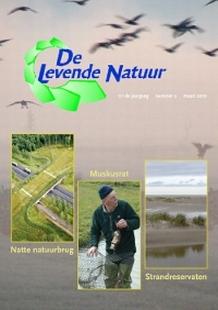De Levende Natuur nummer 2 van 2010 (English summary)
Afbeelding

Monitoring wildlife overpass use by amphibians
E.A. van der Grift, F. Ottburg, R. Snep, E. van Ingen & H. van Beusekom
In The Netherlands wildlife overpass ‘Groene Woud’ is one of the first that aims to provide habitat connectivity for amphibians. In both the design and management of the overpass much attention has been given to create optimal humid conditions for amphibians, including a chain of small pools across the overpass and its access ramps. The question we addressed is if the measures significantly improve the use of the overpass by amphibians. We monitored amphibians 1-2 times a week at the overpass and in the direct surroundings for three years (2006-2008). We analysed the impact of the overpass adaptations on amphibian use by comparing amphibian numbers in the wetland zone on the overpass with amphibian numbers in the dry zone on the overpass. We found that, depending on general weather conditions, the adaptations to maintain a humid environment on the overpass and its ramps significantly improve overpass use by amphibians. As a result wildlife overpasses with special adaptations as implemented at the Groene Woud overpass may become an alternative, and less costly, measure than elevating roads to restore habitat connectivity for semi-aquatic species in wetland areas.
Towards impartial population estimates of (persecuted) Muskrats in The Netherlands
D. Bos, J. van Belle, S. van Wieren, R. Ydenberg & P.W. Goedhart
The Muskrat (Ondatra zibethicus) is an introduced species in Western Europe. The species is heavily persecuted in The Netherlands due to its habit of digging burrows in embankments and dikes. The public debate on the necessity of the current Muskrat population control regime is hampered by a lack of insight into Muskrat population dynamics, the risk of damage at different densities and the effect of the control programme. We reconstructed local Muskrat population trajectories from annual (1987-2007) data on the numbers of harvested Muskrats and catch effort, in a large sample using Sequential Population Analysis. Alternative strategies to the current year-round control programme were studied using a simulation model. This programme still has to be valided in field experiments. Based on the current insights we conclude that year-round intensive harvesting will be the most effective way to keep Muskrat populations low. This results in fewer animal deaths (and consequently less suffering) relative to harvesting at intermediate intensity. This situation has been reached in some parts of The Netherlands, but in others the harvest proportion can be increased. It is worthwhile to consider whether the policy aim (in terms of population size and acceptable level of damage) should be equivalent across the entire country. If not, regionally differentiated control methods could be applied.
Use and welfare of herbivores used for nature management in metal polluted reserves
S. Roggeman, G. De Boeck & L. Bervoets
Metal pollution is worldwide still one of the most important environmental issues. During 2007 the effects of metals on horses and cows from polluted and unpolluted nature reserves were studied in order to evaluate possible health problems. Konik horses and Galloway cows from nature reserves and dairy cows from commercial farms were sampled. All animals were selected based on age, sex and exposure time. From the horses and cows from nature reserves we sampled hair and blood. From dairy cows, sampled in the slaughterhouse additionally liver, kidney, muscle, lung and feces were taken. In all tissues metal concentrations (Cd, Pb, As, Cu, Fe, Al, Cr, Mn, Co, Ni, Ag & Zn) were measured. In the blood we also measured some hematological parameters, ions and the biomarkers alanine aminotransferase (ALT) and Aspartate aminotransferase (AST). In liver and kidneys, the concentration of the metal binding protein ‘metallothionein’ (MT) was measured. During this study no apparent health problems in Galloways were found despite the elevated concentrations of Pb, Cd and As in the hair of animals from polluted areas. In all kidneys of dairy cows the theoretical detoxification capacity for Cd was exceeded. However, indications for health problems in horses were found, such as indications of kidney damage and/or liver damage observed by the blood biomarkers. Based on these results, some guidelines were proposed for nature managers to deal with metal polluted nature reserves where grazers are used for management.
Beach reserves: for nature and coastal safety
R.B.J. Engelbertink, M.P.C.P. Paulissen, G.M. Janssen, T.J. Vanagt & P.A. Slim
Beaches in The Netherlands are subject to a number of serious disturbance factors. They are affected by sand nourishments, resulting in high mortality in macrofaunal communities of the beach and foreshore. Consequently, this also affects foraging fish and birds. The sand material used for nourishments is often of a different composition and grain size than that of the local beach and foreshore, which is of great significance to the coastal habitats and its biota. Dutch beaches are also heavily frequented by tourists and visitors. Recreational use of beaches often involves beach cleaning and disturbance of (breeding) birds. Because of these pressures the duneforming processes are hampered and the natural gradual gradient between sea and dunes with characteristic habitats and target species is disappeared. In order to release the pressures adequate protection of beach ecosystems is urgent. Beach reserves can contribute to this. In this article we illustrate the concept of beach reserves.

